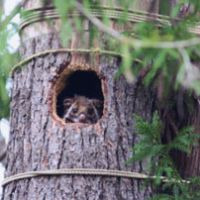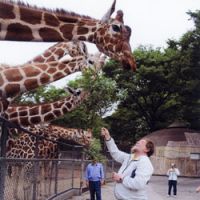I was born in 1940, in Neath, South Wales. My father went off to war and my mother took me to live in the relative safety of rural Suffolk in eastern England, where the Luftwaffe's bombers seldom attacked. There, she worked as a nanny for rich people's offspring. It was pretty tough for my Mum, but she managed to get a small house in the town of Ipswich, which was where I first went to school.
Even as a small child, though, I pined for Wales. As far back as I can remember, we would return there in the holidays. During the war that meant taking a train from Ipswich to London, then changing to another one from a different station. From there the line took us across the country, through a tunnel under the River Severn and so eventually to South Wales.
That change in London usually left us with quite a bit of time between trains, so whenever I got my way — and I could be a stubborn little brat — my mother took me to the zoo. It was there that I first saw lions and tigers and elephants. When I was about 5, I asked why those animals had to be locked up.
"To stop them from eating people," was the answer my mother gave me. It made sense at the time, because I surely didn't want to get eaten.
As I got older, until I was 12 or so, the zoo still fascinated me, but I really did think about the fate of those caged animals, and by then I was aware of the lands they came from. Was it right to capture and cage wild animals, just to have people gawp at them?
Fast forward: At age 27, I was a game warden in Ethiopia. At the time, I had a young American volunteer working in the park. He was a Peace Corps member who wanted to get away from towns and villages and work with wildlife. His name was Tag Demment.
One night Tag brought two young lions into the park. They had been orphaned just after weaning, and Tag's idea was to raise them to be efficient enough at hunting so that we could release them in an area that had few, if any, domestic animals. We kept them until they were pretty big, and could kill a live goat. They were a lot of fun — and at times a hell of a bloody nuisance, but that's another story. They certainly could not be released in our park area, which had many villages and many domestic animals. However, the lions were eventually released, and I hope they survived, but we had neither the funds nor the time to keep monitoring them.
At that time in the Simien Mountain National Park, our main focus was on the protection of the Walia ibex, of which only about 150 were left. The conservation situation was pretty desperate in Ethiopia, and with the threat of civil unrest looming, it didn't seem to be getting any better. There was some serious talk of capturing a few of these rare ibex and transporting them to a zoo in Switzerland. We really had some heart-searching discussions about this. Some believe that zoos are not only for entertainment and education, but that they can preserve species from threatened habitats. The dream is to eventually improve or restore the habitat so the rare species can be once again released. This did not happen with the Walia ibex, and soon the country was engulfed in a military revolution and mayhem.
This year was the 50th anniversary of the founding of the Tama Zoo. I was asked to be Head Keeper for a day. When the invitation first came, the little boy in me was reawakened. I loved the trains that took me to South Wales when I was small, but I'd never dreamed of becoming a train driver. From time to time, though, I had imagined myself working in a really good zoo, where the animals were given space.
Tama Zoo is probably one of the best zoos in the world. It is set in 52 hectares of rolling, forested hills and valleys. There is not a huge collection of animals, but their selection is excellent. Kids fall in love with the lesser pandas, and the Lion Bus ride is exciting and memorable. The orangutans have a 150-meter "Sky Walk," which they swing across above the visitors' heads. There are rhinos, elephants, cheetahs, snow leopards, chimpanzees — all in thoughtfully prepared environments. One of the most interesting is the Mole House, where you can see those small burrowing insectivores scurrying through mesh tunnels above your head.
Another enjoyable thing about Tama Zoo is that you stroll through natural settings of woods and springs, and the cries of wild Japanese birds and frogs mingle with the sounds of the zoo creatures as you enjoy a hilly hike under green trees. Tama Zoo is easily reached, and it's a great place to take the kids. (Look it up on the Internet.)
On May 8, when I was Head Keeper, entrance was free. The park was really crowded then, but normally there are only a few thousand people, so you can avoid long lines.
I was allowed to go into the back of the orangutan facilities to meet face to face with the remarkable beings there. Looking into an orangutan's eyes makes it impossible, for me anyway, to think of them as animals. Some 20 years ago, I had the same feeling gazing into the eyes of wild mountain gorillas in Zaire. At Tama Zoo it made me feel guilty to be on the outside of a cage, with them inside. On the other hand, my heart was torn a couple of months ago to see photographs of a wild gorilla slaughtered by poachers or renegade militiamen. Seeing those images brought about a helpless rage that I'm sure many of you shared if you saw them.
Nobody is going to shoot an orangutan in Tama Zoo, and the keepers are really emotionally involved with them, as they are indeed with all the other creatures in their charge. There are so many humans in the world, and so few wild gorillas or orangutans, and they are genetically so very close to us. What is the future of such creatures? Is it to be wild and free, but always in mortal danger? Or protected and safe, but locked away? I wish I had the answer.
I know that I have a picture, a work of art that I always treasure. It was drawn by a 56-year-old lady orangutan. Every day the keeper gives her a box of crayons and a cardboard sheet, and each picture she creates is different, as is her choice of colors.
The day I spent as Head Keeper at Tama Zoo was really enjoyable, and has triggered a lot of soul-searching in me about the future of wildlife on our planet — and whether or not humanity as a whole is worthy of the huge task of trying to understand and live in harmony with it.
Afterward, I came back to our little woods here in Kurohime, Nagano Prefecture, where our most venerable trees are only about 60 years old and we don't have many hollows in them to make nesting places for owls, bats and so forth. That is why we have placed nest boxes in the trees, which the owls have been using to raise their young.
This year though, a young owl couple chose to make a nest in a small hollow in a silver birch tree, originally dug out for a nest site by a woodpecker. So far the two young owl nestlings are doing fine. A little distance away we had put up a new nest box, ostensibly for the owls, made from a hollowed-out length of trunk. This has been occupied not by owls, but by flying squirrels — a new record for our woods that pleases us all. Yet another positive record this spring has been a photograph we caught of a badger (not a tanuki, or raccoon dog — we've had those for the last 20 years) rambling across some of our newly planted woodland. We all hope that the badgers will make a den in the woods. They are among my favorite creatures, and in the last 20 years in Japan they have become increasingly rarely seen.




















With your current subscription plan you can comment on stories. However, before writing your first comment, please create a display name in the Profile section of your subscriber account page.